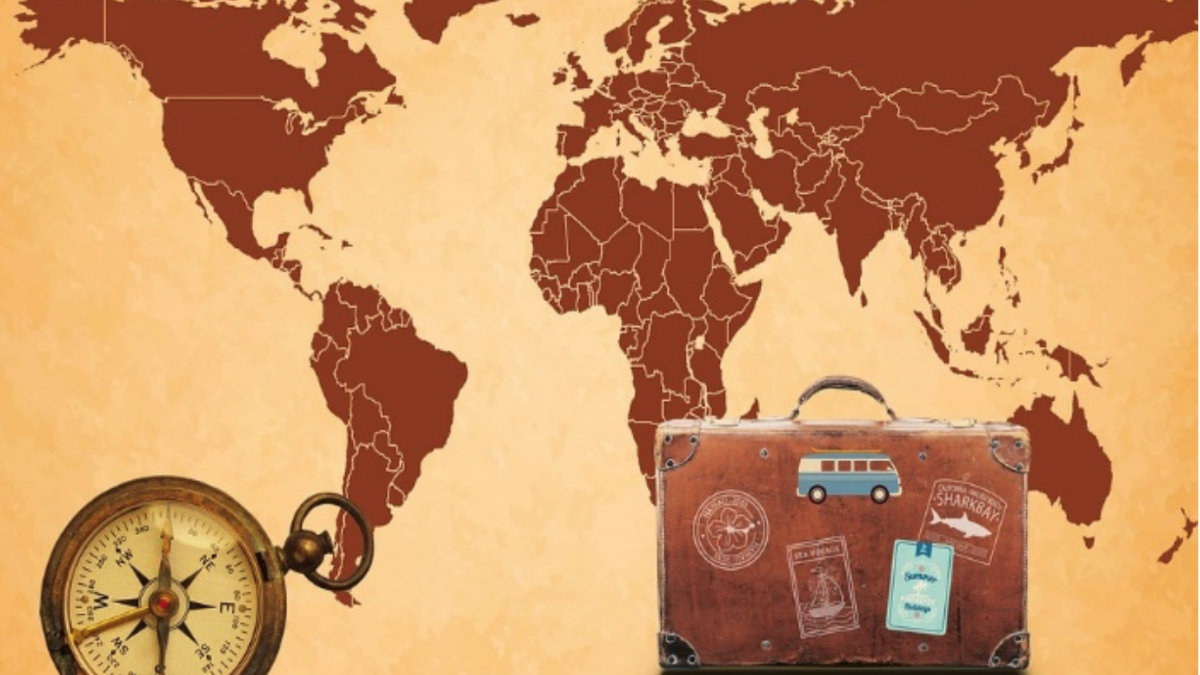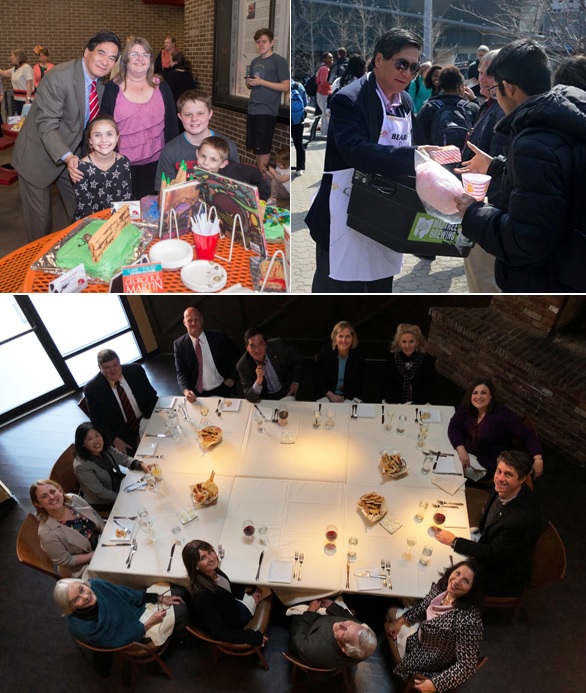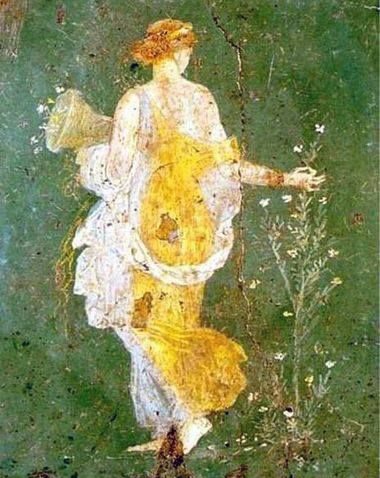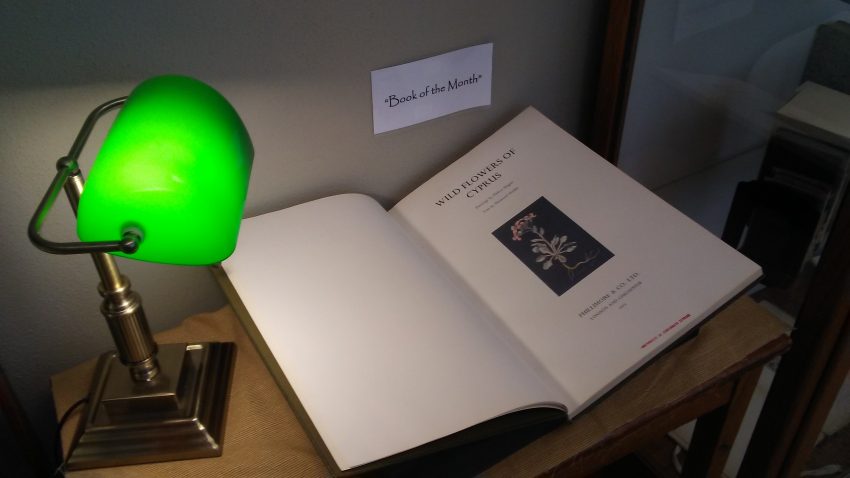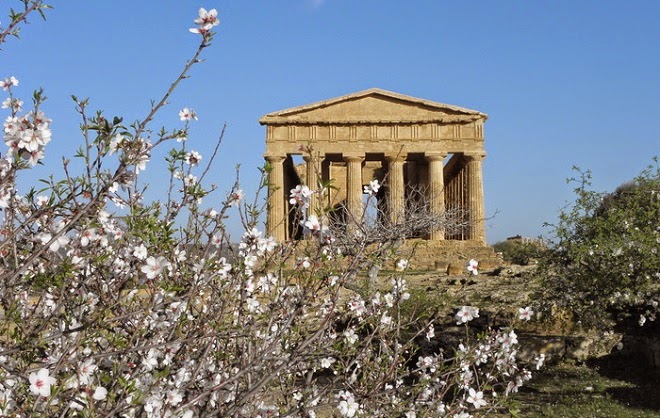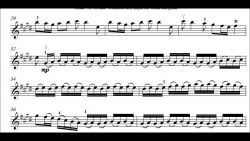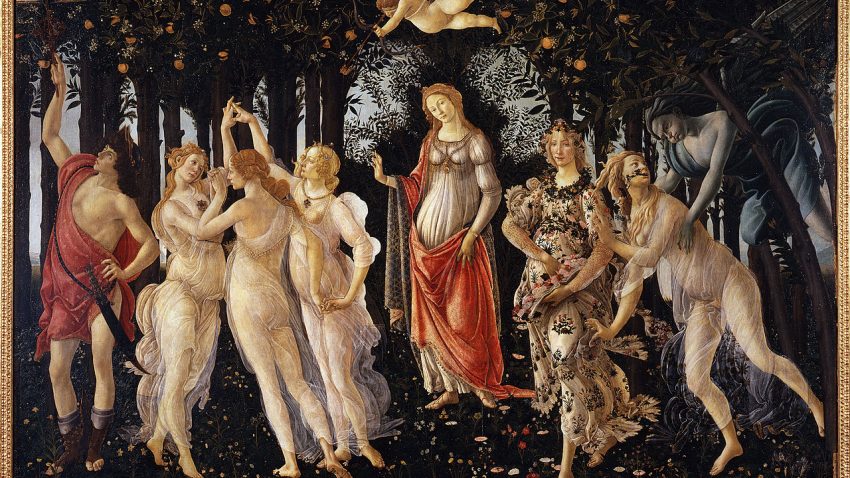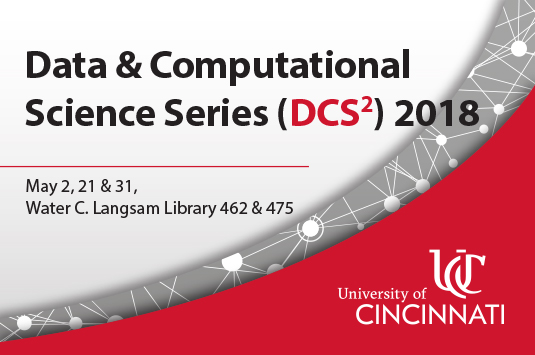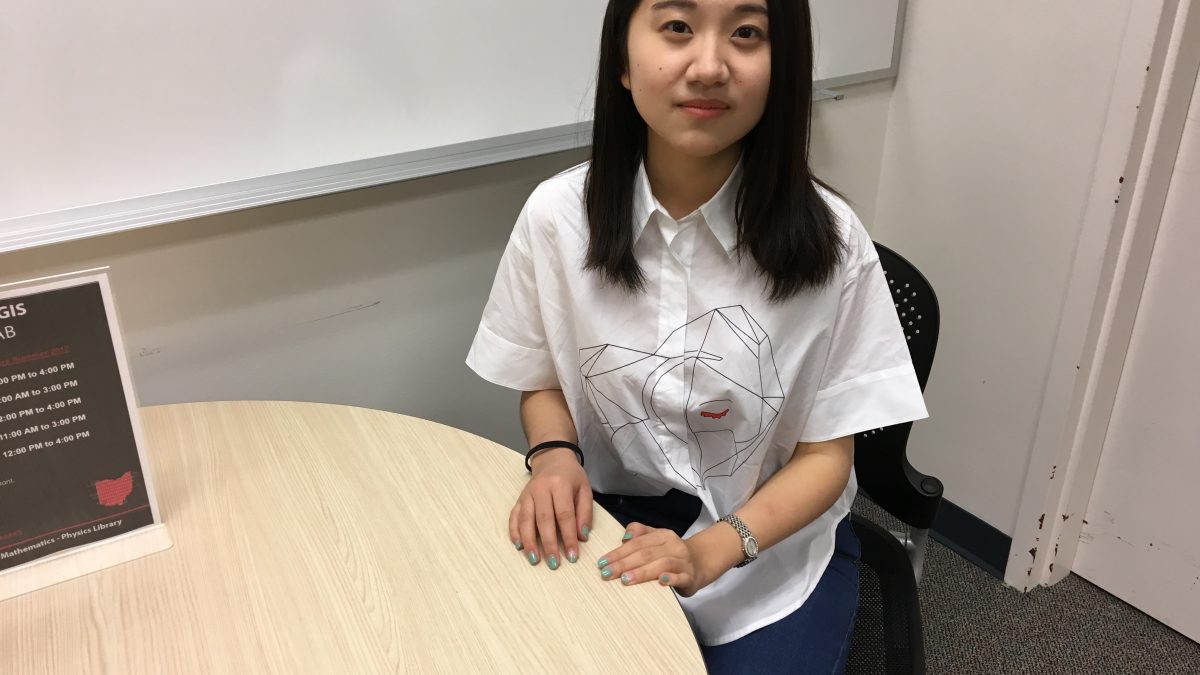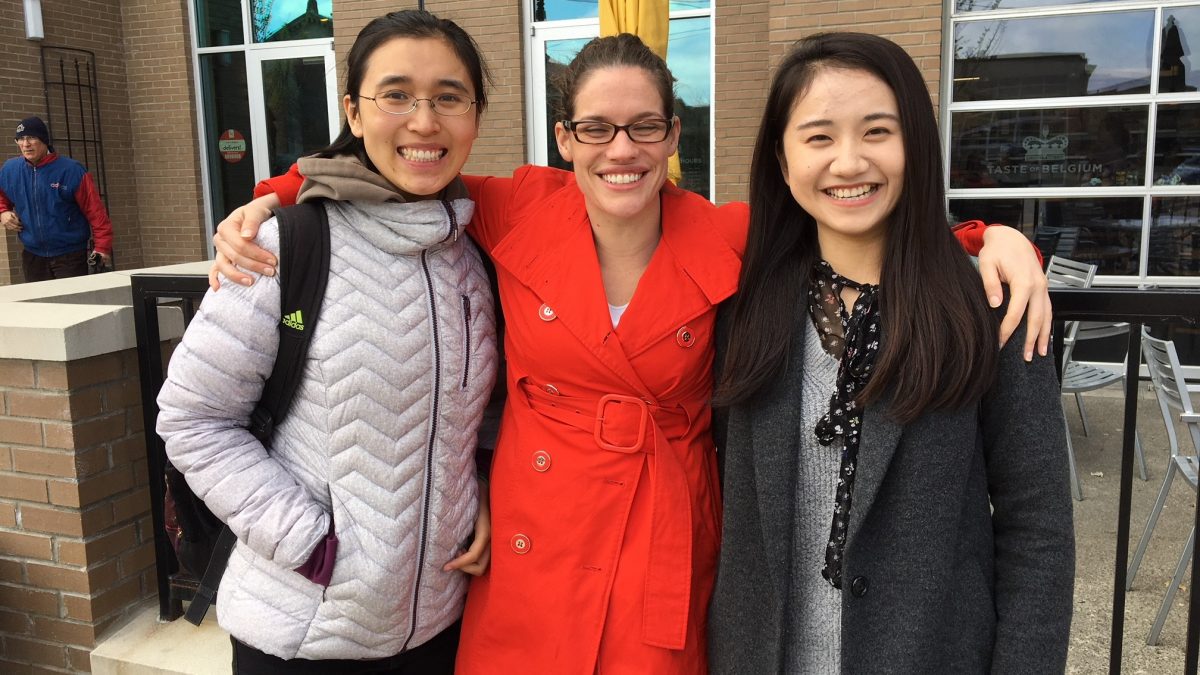In Europe, practically every day is a communal holiday of some kind. Various saints are celebrated among Roman Catholics and Greek Orthodox, one of countless remnants of pagan gods and goddesses, the original protectors and healers, and whose birthdays were celebrated with processions, song and dance, athletic competitions, the eating of special foods and fasting, libation offerings and purifications, and sometimes with a sacrifice of plants or animals.
On Sunday, therefore, we will take the opportunity to celebrate the “birthday” of Artemis (St. Artemisius and St. Artemidos) and on Monday, it’s Apollo’s turn (7. Thargelion). The Athenian Thargelia festival dedicated to both Artemis and Apollo is most famous for picking two scapegoats (φάρμακοι) that were driven out of town to rid it of sins and plagues. In Ionia, including at Ephesus, one of the months was named after Artemis, Artemision (corresponding more or less to April [with lunar and lunar-solar calendars versus solar it’s a bit complicated]) and in Macedonia, Artemisius (corresponding more or less to May).
May 6 (6. Thargelion) is the Athenian birthday of the greatest of the Greek goddesses – Artemis (as Artemis Ephesia worshiped by “Asia and the whole world” ([Acts 19:27]). In the 2nd century an entire month named after the goddess, Artemision, was a non-working holiday at Ephesus (IvE I 24). After a hectic year, the library staff would, I’m sure, happily embrace an off-work month-long period of celebration (or rest;-)!
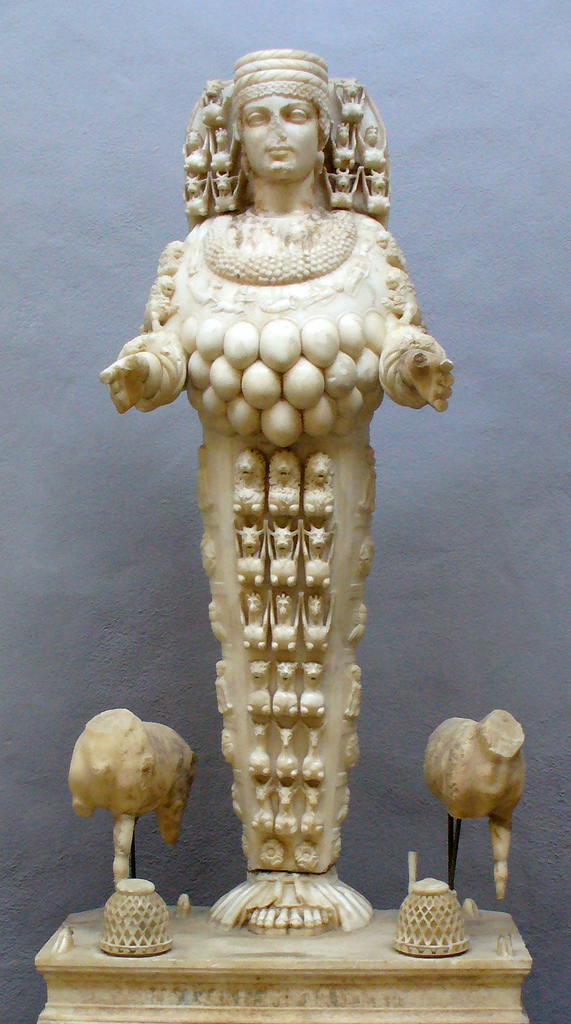
Artemis Ephesia, providing sustenance to all (Orphic Hymn 36 (To Diana), 12).
Artemis’s temples were the most numerous, especially on the Peloponnese, and the number of her epithets was surpassed only by those of Zeus. One would think that it should also be the birthday of her twin brother Apollo. However, traditions vary. In some she has no connection to Apollo and in others she even acts as midwife at the birth of her own twin brother.
Artemis was the goddess of all living things, animals and plants, but really all of nature – mountains, groves, marshes. Only later did she become the goddess of hunters. The hind was her companion, not her victim. She was associated with several Near Eastern goddesses – Anath (Hazleton, 2004, p. 114), Tanit (who shares many of Artemis’ attributes, the dove, palm tree, fish, and moon crescent), Belili (goddess of trees, the moon, wells, springs, and the willow – all sacred to Artemis), Astarte (Ishtar) (LIMC 2: 1, p. 618), Isis (LIMC 2: 2 912-913), Tyche (LIMC 2: 2 (Artemis) 893-899), Bendis (Hdt. 4.33; 5.7), Cybele (LIMC 2: 1 p. 618), the Minoan-Mycenaean goddess (Nilsson, 1971 [1950], p. 503), all stewards of nature; she is clearly mentioned in a Linear B tablet from Pylos — a-ti-mi-te (Bennett, 1955, p. 209, classification Un 219.5).
οἴκτῳ γὰρ ἐπίφθονος Ἄρτεμις ἁγνὰ πτανοῖσιν κυσὶ πατρὸς αὐτότοκον πρὸ λόχου μογερὰν πτάκα θυομένοισιν, στυγεῖ δὲ δεῖπνον αἰετῶν… τόσον περ εὔφρων ἁ καλὰ δρόσοις ἀέπτοις μαλερῶν λεόντων πάντων τ᾿ἀγρονόμων φιλομάστοις θηρῶν ὀβρικάλοισι τερπνά… (Aesch. Ag. 134-143).
For holy Artemis, out of pity, bears a grudge against the winged hounds of her Father who slaughtered the wretched hare, litter and all, before it could give birth; she loathes the eagles’ feast…So very kindly disposed is the fair one to the unfledged seed of fiery lions, and so pleasing to the suckling whelps of all beasts that roam the wild… (modified Loeb trans.).
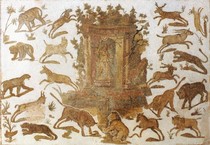
Pavement mosaic. Thysdrus, Tunisia. 2nd-3rd cent. CE.
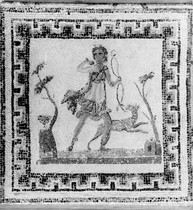
Another pavement mosaic from Tunisia from the same period.
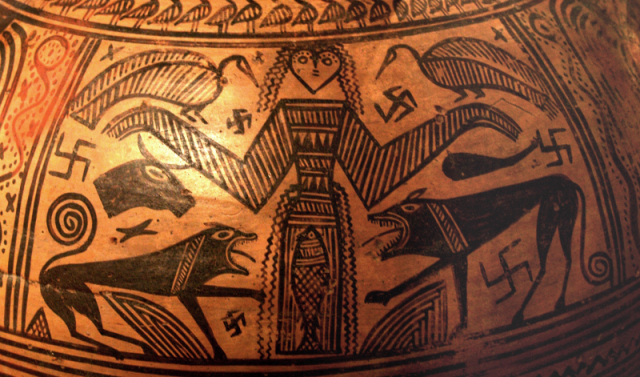
Goddess of animals. The so called potnia thērōn (πότνια θηρῶν, “mistress of animals”) motif. Boeotian pithos-amphora, c. 680-670 BCE. Athens, National Museum (NM 200).
However, she was also a goddess of culture – presiding over the education of young girls and boys and of cities, too. She was the protector of youth, especially young women during rituals celebrating their menarche (at Brauron, Mounychia, Sparta, Larissa, Halai Araphenides, and many more). Song and dance took center stage in these ceremonies. Girls and young women in choruses for Artemis abound in literature.[1]
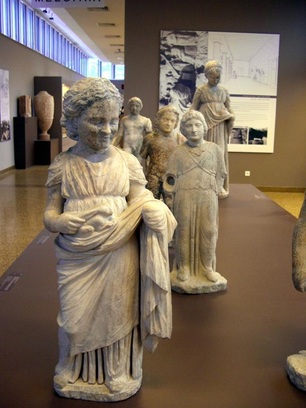
A ”bear” (ἄρκτος) to-be (the menarchical stage during rites of passage) at the Artemis sanctuary in Brauron, north-east of Athens, giving a rabbit as a gift to the goddess.
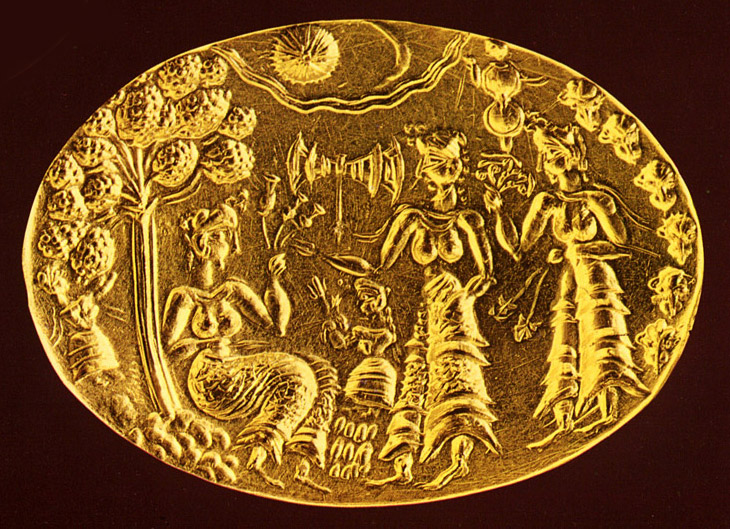
Minoan-Mycenaean seal-ring of gold discovered at the Ramp House on the Mycenaean acropolis. Possible “rites of passage” scene in an outdoor setting with sun and moon, river, trees, cliffs, mountains, groves with the “labrys” (butterfly, poorly labeled, “double axe”), a symbol of the goddess, similar to the fish and cross as symbols of the Christ figure, and the goddess as “larva” (poorly labeled “shield of eight”), the earlier, younger, stage of the butterfly. Young women collecting various flowers used to alleviate and reduce cramps and labor pangs and bring about the onset of menstruation and ensure the health of a potential future mother — saffron crocuses, lotuses, poppies (a check on menstruation), lilies (an “emollient of the uterus,” Pliny. NH 21.126). CMS-I-017-1.
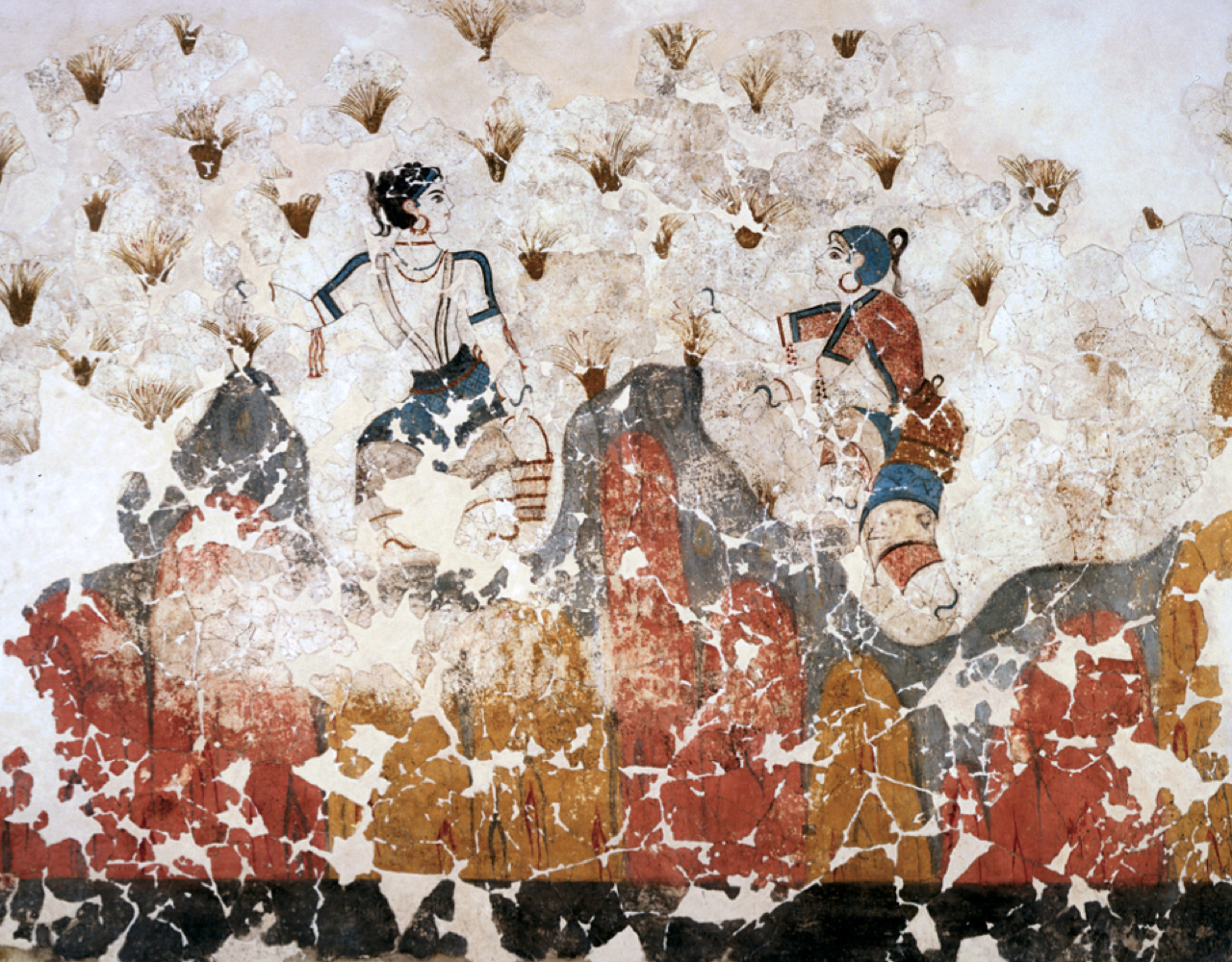
Girls with shaved heads as part of their “rites of passage,” picking saffron crocuses in preparation for and celebration of their menarche. Even today, saffron is used to alleviate menstruation cramps and premenstrual symptoms. Wall painting from the East Wall of Room 3a of House Xeste, Akrotiri, Thera, c. 1700-1450 BCE.
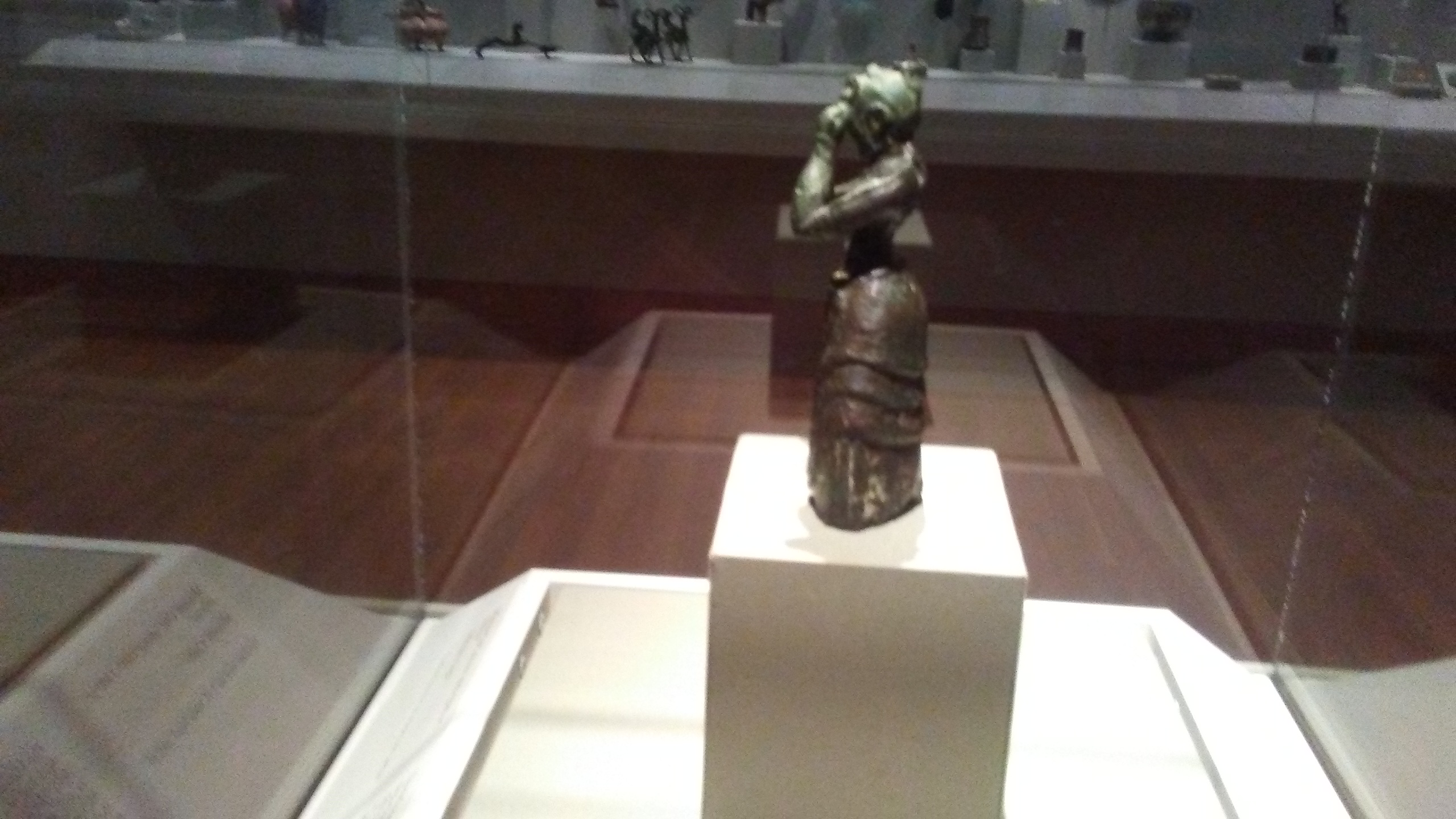
“Minoan girl,” c. 1600-1500 BCE. Cleveland Art Museum, Ohio. Unique bronze statuette of a pre-adolescent girl with partially shaved hair.
As a virgin goddess (in fact, she is one of only three goddesses (Hestia and Athena being the other two) over whom Aphrodite has no power (Homeric Hymns [to Aphrodite, 6-32]), she is the patron of unmarried women and men, children, and all first born, human and non-human alike.
ἣ δὲ μάλ᾿ οὐκ ἔθελεν, ἀλλὰ στερεῶς ἀπέειπεν,
ὤμοσε δὲ μέγαν ὅρκον, ὃ δὴ τετελεσμένος ἐστίν,
ἁψαμένη κεφαλῆς πατρὸς Διὸς αἰγιόχοιο,
παρθένος ἔσσεσθαι πάντ᾿ ἤματα δῖα θεάων.
τῆι δὲ πατὴρ Ζεὺς δῶκε καλὸν γέρας ἀντὶ γάμοιο…
(Hymn. Hom. Ven. 25-29).
She was wholly unwilling, even stubbornly refused;
and touching the head of father Zeus who holds the aegis,
she, that fair goddess, swore a great oath
that she would be a virgin always and
her father Zeus granted her a fine privilege instead of marriage…
(modified Loeb trans.).
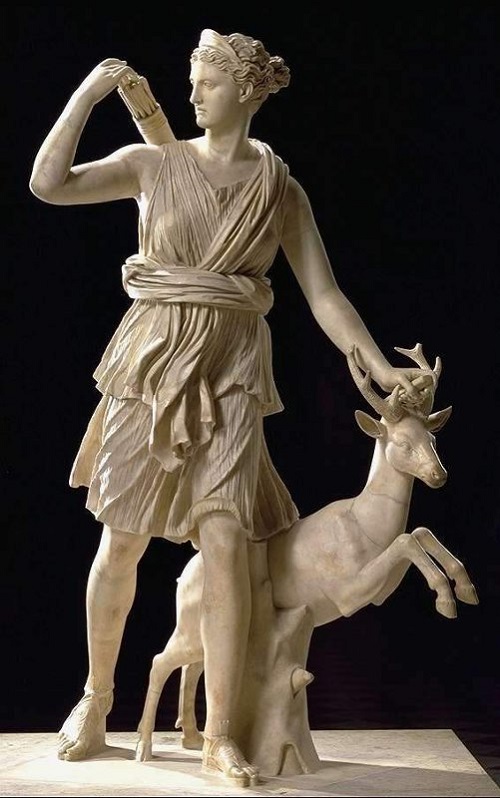
“Diana of Versailles,” a Roman marble copy of a Greek original from c. 325 CE by Leochares Louvre. In simplified terms, Diana was the Roman equivalent to Artemis.
…ὡς ὅτε πατρὸς ἐφεζομένη γονάτεσσι παῖς ἔτι κουρίζουσα
τάδε προσέειπε γονῆα δός μοι παρθενίην αἰώνιον, ἄππα,
φυλάσσειν, καὶ πολυωνυμίην, ἵνα μή μοι Φοῖβος ἐρίζῃ…
…δὸς δέ μοι ἑξήκοντα χορίτιδας Ὠκεανίνας, πάσας εἰνέτεας,
πάσας ἔτι παῖδας ἀμίτρους…δὸς δέ μοι ἀμφιπόλους
Ἀμνισίδας εἴκοσι νύμφας… δὸς δέ μοι οὔρεα πάντα·
πόλιν δέ μοι ἥντινα νεῖμονἥν τινα λῇς… (Call. Hymn 3.4-7; 19-20).
…when sitting on her father’s knees, still a child, she spoke these words to her father:
“Let me keep my virginity, Father, forever: and give me many names,
so that Phoebus may not compete with me…
…And give me sixty daughters of Oceanus for my choir, all nine years old,
all virgins yet ungirdled…and give me for companions twenty nymphs of Amnisus…
And give to me all mountains; and for city, assign me any, even whichever you will…
(modified Loeb trans.).
Her mythical companions included several famous virgins (Iphigenia, Atalanta, Callisto, Hippolytus, and countless more). Euripides’s famous play tells the tale of the tragic fate of the virgin Hippolytus.
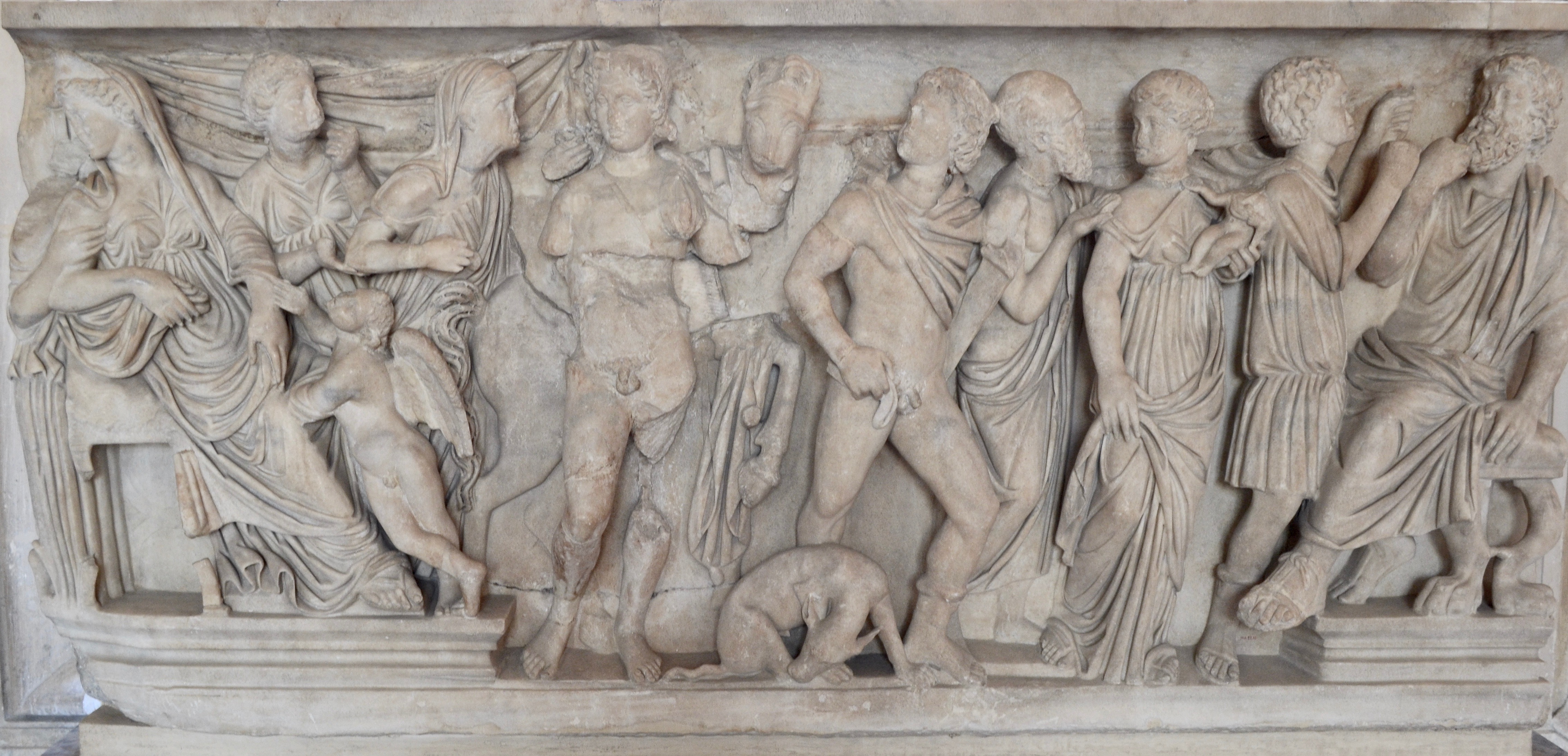
Hippolytus and sad dog, presumably sad over the pending death of its guardian. Marble sarcophagus, c. 290 CE. Louvre. MA 2294.
ΑΡΤΕΜΙΣ: ὦ τλῆμον, οἵᾳ συμφορᾷ συνεζύγης· τὸ δ᾿ εὐγενές σε τῶν φρενῶν ἀπώλεσεν.
ΙΠΠΟΛΥΤΟΣ: ἔα· ὦ θεῖον ὀσμῆς πνεῦμα· καὶ γὰρ ἐν κακοῖς ὢν ᾐσθόμην σου κἀνεκουφίσθην δέμας· ἔστ᾿ ἐν τόποισι τοισίδ᾿ Ἄρτεμις θεά.
ΑΡΤΕΜΙΣ: ὦ τλῆμον, ἔστι, σοί γε φιλτάτη θεῶν.
ΙΠΠΟΛΥΤΟΣ: ὁρᾷς με, δέσποιν᾿, ὡς ἔχω, τὸν ἄθλιον;
ΑΡΤΕΜΙΣ: ὁρῶ· κατ᾿ ὄσσων δ᾿ οὐ θέμις βαλεῖν δάκρυ.
ΙΠΠΟΛΥΤΟΣ: οὐκ ἔστι σοι κυναγὸς οὐδ᾿ ὑπηρέτης.
ΑΡΤΕΜΙΣ: οὐ δῆτ᾿· ἀτάρ μοι προσφιλής γ᾿ ἀπόλλυσαι.
ΙΠΠΟΛΥΤΟΣ: οὐδ᾿ ἱππονώμας οὐδ᾿ ἀγαλμάτων φύλαξ.
ΑΡΤΕΜΙΣ: Κύπρις γὰρ ἡ πανοῦργος ὧδ᾿ ἐμήσατο.
ΙΠΠΟΛΥΤΟΣ: ὤμοι, φρονῶ δὴ δαίμον᾿ ἥ μ᾿ ἀπώλεσεν.
ΑΡΤΕΜΙΣ: τιμῆς ἐμέμφθη, σωφρονοῦντι δ᾿ ἤχθετο.
ΙΠΠΟΛΥΤΟΣ: τρεῖς ὄντας ἡμᾶς ὤλεσ᾿, ᾔσθημαι, μία.
ΑΡΤΕΜΙΣ: πατέρα γε καὶ σὲ καὶ τρίτην ξυνάορον (Eur. Hipp. 1389-1404)
Artemis: O poor man, to what a calamity you are yoked! Yet it was the nobility of
your mind that destroyed you.
Hippolytus: But what is this? O breath of divine fragrance! Though I am in misfortune
feel your presence and my body’s pain is lightened. The
goddess Artemis is in this place!
Artemis: Poor one, she is, dearest of gods to you.
Hippolytus: Do you see me, lady, see my wretched state?
Artemis: Yes, but the law forbids my shedding tears.
Hippolytus: No more do you have your huntsman and your servant!
Artemis: No, but though you die, I love you still.
Hippolytus: No one to tend your horses or your statue!
Artemis: No, for unscrupulous Cypris willed it so.
Hippolytus: Ah, now I learn the power that has destroyed me!
Artemis: The slight to her honor angered her, and she hated your chastity.
Hippolytus: One power destroyed us three, I see it now.
Artemis: Your father, you, and Theseus’ wife the third (modified Loeb trans.).
Artemis had also healing powers. As Artemis Podagra she cured gout, as Artemis Chelytis coughing (Clem. Alex. Protrepticus 2, pp. 32, 33 quoting Sosibius), as Artemis Rhokkaia rabies (Ael. NA 14.20) and as Artemis Kokkōka menstruation cramps and labor pangs (incomprehensible to poor Pausanias 5.15.7-8). As Artemis Thermia she presided over healthful hot springs (CIG 6172) and as Artemis Sōteira and Artemis Locheia she helped women in childbirth (Paus. 3.22.12).
She sought to protect virgins in her fold from men pursuing them, but also animals. According to some versions of this famous myth, Artemis transformed the hunter Actaeon into a stag to be torn to pieces by his own hunting dogs after he killed a deer. The more popular version, though, is the one in which Artemis punished him after he had come upon the goddess bathing naked in a stream with her companion nymphs (Ovid. Met. 3.138ff.). Euripides in Bacchae uses a version in which she kills him for having boasted that he surpassed her as a hunter (339-340). A children’s cartoon on American TV a couple of years ago featured a version in which Artemis transformed the hunter Actaeon into a stag to teach him a lesson about not killing animals. The terrified deer (Actaeon) attempted to speak but was unable to make himself understood without a human language. As his fellow hunters are poised to throw their spears and shoot their arrows and the hunting dogs are about to pounce upon the deer Actaeon, he promises Artemis that, if she would only change him back into human form, he would never harm another living being and that he would educate his fellow hunters about the plight and suffering of hunted animals, which was indeed the happy outcome.
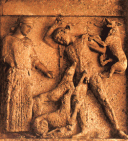
Metope from Temple E, Selinus, Sicily c. 460 BCE.
We could end on this cheerful note, but Artemis was a complex goddess. Human sacrifice was also associated with her, especially at Taurus, of all foreign males.
τὰ τῆς θεοῦ δὲ μέμφομαι σοφίσματα,
ἥτις βροτῶν μὲν ἤν τις ἅψηται φόνου,
ἢ καὶ λοχείας ἢ νεκροῦ θίγῃ χεροῖν,
βωμῶν ἀπείργει, μυσαρὸν ὡς ἡγουμένη,
αὐτὴ δὲ θυσίαις ἥδεται βροτοκτόνοις (Eur. IT 380-384).
I criticize Artemis’ clever logic if a mortal
is involved in bloodshed or touches a new
mother or a corpse, she shuts him out from
her altar as polluted, but she herself takes
pleasure in human sacrifice (modified Loeb trans.).
But also of women, virgins, to which the famous sacrifice of Iphigenia, to allow the Greeks favorable winds to sail against Troy, attests.
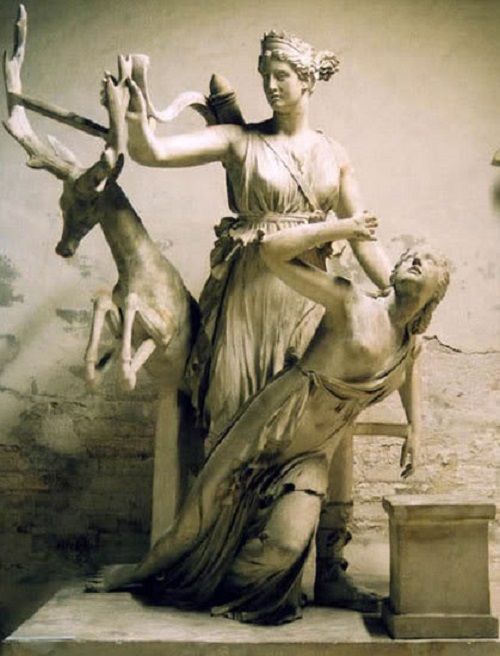
As a “deus ex machina” in Euripides’s play Iphigenia at Aulis, Artemis appears in the last minute to rescue Iphigenia. As with most literary motifs in classical antiquity there are numerous versions. In the 7th century Kypria by Stasinos (a summary in Proclus, Chrestomathia, 47-51, as preserved in Photius), Artemis substitutes Iphigenia for a hind as in Euripides. Stesichorus in the Oresteia, on the other hand, follows Hesiod in the Catalogue of Women fr. 19 (Philodemus Piet. 2.5; Oresteia – Piet. 215 — book 1 or 2) in substituting Iphigenia for an image (εἴδωλον), after which Artemis makes her immortal as Artemis of the Crossroads (Εἰνοδία), i.e., Hecate (Paus. 1.43.1). In Pindar’s eleventh Pythian Ode, Iphigenia is killed without any substitution or rescue. In the scholium of the Leiden manuscript of Aristophanes’ Lysistrata 645, Euphorius claims that Iphigenia was sacrificed at Brauron (not at Aulis as in Euripides and others) and that a bear was substituted for her, and Nicander and Phanodemus (FGrH. 325 F14 – Etym. Magn. s.v. Ταυροπόλον) claim it was a bull. In most versions, though, Artemis substituted Iphigenia for a hind deer making Iphigenia her priestess in the land of the Taurians (Proclus’ Chrestomathia [from the Kypria]), Euripides, Iphigenia at Aulis; LIMC 2: 2 1373-1384). A reconstruction from a marble sculpture in the Ny Carlsberg Glyptotek. Copenhagen.
In Aeschylus’ Agamemnon (209-217), the seer gives Artemis as the cause of the sacrifice.
μιαίνων παρθενοσφάγοισιν ῥείθροις
πατρῴους χέρας πέλας βωμοῦ·
τί τῶνδ᾿ ἄνευ κακῶν;
πῶς λιπόναυς γένωμαι
ξυμμαχίας ἁμαρτών;
παυσανέμου γὰρ θυσίας
παρθενίου θ᾿αἵματος ὀργᾷ
περιόργῳ σφ᾿ ἐπιθυμεῖν θέμις.
polluting a father’s hands with streams of a
slaughtered maiden’s blood close by the altar.
Which of these options is free from evil?
How can I become a deserter of the fleet,
losing my alliance? That they should long
with intense passion for a sacrifice to end
the winds and for the blood of a virgin (modified Loeb trans.).

The Sacrifice of Iphigenia. Casa del Poeta Tragico, Pompeii, c. 79 CE, terminus ante quem. Naples.
Lucretius’ famous polemic against an unjust religion uses the sacrifice of Iphigenia as an exemplum:
…as when at Aulis, the altar of our Lady of the Crossroads
was foully defiled by the blood of Iphianassa [Iphigenia], shed by chosen
leaders of the Danai, best of men. As soon as the ribbon had
bound her virgin hair falling in equal lengths down either
cheek, as soon as she saw her father standing sorrowful
before the altar, and by his side attendants hiding the knife,
and the people shedding tears at the sight of her, mute with
fear, she sank to the ground on her knees. Poor girl! It did not
help her at such a time that the name of father had been given
the king first by her; for lifted up by the hands of men, all
trembling she was brought to the altar, so that she not in
solemn and sacred ritual might be escorted by loud
wedding song, but a pure virgin to fall by impure hands
at the age of marriage; a victim sorrowful killed by a father’s
hand; all in order that a fair and fortunate release might
be given to the fleet. So powerful was Religion in persuading
evil deeds (Lucretius. De rerum natura 1.83-101, Loeb trans.).
Feminists can claim Artemis as theirs because of her eternal virginity and refusal to marry and have children, and instead choose the company of women, nymphs, and animals. Sexists may also have a case since Artemis could turn against women who defied her by either voluntarily (e.g., Melanippe) or involuntarily (e.g., Callisto, Polyphonte) lose their virginity. Animal rights advocates can also claim her as a protector of animals and all of nature, but those who take pleasure in killing animals, hunters, can also claim her as theirs. Those who celebrate life can claim her as a protector of children, human and non-human, also her association with Eileithyia, the goddess of childbirth, in spite of her own virginity, but so can those who relish in death and destruction since she also demanded human sacrifice and ruthlessly killed all seven of Niobe’s daughters (notwithstanding variations on “all” and the number). Witches can claim her as their high priestess. Many of her festivals were at night under torch-light and the full moon (also her associations with Selene and Hecate) and many healing herbs were under her purview. Witch-hunters can also claim her for the same reasons, honoring Tatian’s famous aspersion against her as a poisoner and Torquemada’s claim that she was the Devil. However, she was also a goddess of light who spent her days bathing in springs and hiking in the mountains; and, of course, she was a goddess of nature (the countryside) but also of culture (the city) — these seemingly contradictory attributes all at the same time. It has been pointed out that the dualism of our modern western Judaeo-Christian thinking was unknown to the ancient Greeks for whom life and death, light and darkness, were simply inextricably connected aspects of the same thing (there is no death without life and vice versa).
Artemis was a complicated, confusing, and contradictory goddess already in antiquity as many regions claimed her as theirs and assigned her various powers to suit their needs, which also varied throughout the centuries. More than most deities in the Greek pantheon, Artemis has suffered from distortions, confusions, appropriations, misrepresentations, and misinterpretations, beginning already in antiquity and it’s been downhill from there (we as classical scholars are not exempt:-).

Brief recent book bibliography (currently on display in the Classics Library’s Reading Room):
Budin, S.L. 2016. Artemis. New York.
Ellinger, P. 2009. Artémis, déesse de tous dangers. Paris.
Galiano, P., & Vigna, M. 2015. Diana e Apollo: La selva e l’urbe. Rome.
Janda, M. 2016. Artemis mit der goldenen Spindel. Innsbruck.
Léger, R.M. 2017. Artemis and her Cult. Oxford.
Rogers, G. M. 2012. The Mysteries of Artemis of Ephesos. New Haven.
Vincenti, M.C. 2010. Diana: Storia, mito e culto della grande dea di Aricia. Rome.
Critical editions to Callimachus (Hymn 3 to Artemis) and the Homeric Hymns (27 to Artemis and 6 to Aphrodite):
D’Alessio, G.B. 2007. Callimaco. 4th ed. Milan (BUR).
Asper, M. 2004. Kallimachos von Kyrene: Werke, griechisch-deutsch. Darmstadt.
Pfeiffer, R. 1953. Callimachus, vol. ii: Hymni et epigrammata. Oxford (OCT).
Allen, T.W. 1912. Homeri opera, vol. 5. Oxford (OCT).
Baumeister, A. 1894. Hymni Homerici. Leipzig (Teubner).
Càssola, F. 1975. Inni Omerici. Milan (Mondadori).
Crudden, M. 2001. The Homeric Hymns. Oxford.
Humbert, J. 1936. Homère, hymnes. 2nd ed. Paris (Budé).
[1] Hom. Il. 16.181; Hom. Hymn 5 to Artemis 27; Hom. Hymn 3 to Apollo 190; Hom. Hymn 5 to Aphrodite 115; Apoll. Rhodius Argon. 1.1225; and Ael. NA 12.9.


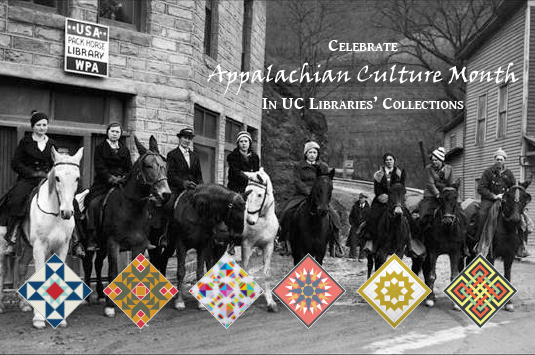 Cincinnati lies just at the border or outer edge of Appalachia, a cultural region in the Eastern United States that stretches from the Southern Tier of New York to northern Alabama, Mississippi and Georgia and includes portions of Pennsylvania, Ohio, North and South Carolina and all of West Virginia. A new exhibit on display on the 4th floor lobby of the Walter C. Langsam Library showcases resources from UC Libraries in celebration of Appalachian culture and heritage. Included are resources from the collections of the Albino Gorno Memorial (CCM) Library, Geology-Mathematics-Physics Library, the Donald C. Harrison Health Sciences Library, College of Engineering and Applied Sciences Library, the Robert A. Deshon and Karl J. Schlachter Library for Design, Architecture, Art and Planning (DAAP), and Langsam. Also featured are online resources that showcase and inform about Appalachian culture.
Cincinnati lies just at the border or outer edge of Appalachia, a cultural region in the Eastern United States that stretches from the Southern Tier of New York to northern Alabama, Mississippi and Georgia and includes portions of Pennsylvania, Ohio, North and South Carolina and all of West Virginia. A new exhibit on display on the 4th floor lobby of the Walter C. Langsam Library showcases resources from UC Libraries in celebration of Appalachian culture and heritage. Included are resources from the collections of the Albino Gorno Memorial (CCM) Library, Geology-Mathematics-Physics Library, the Donald C. Harrison Health Sciences Library, College of Engineering and Applied Sciences Library, the Robert A. Deshon and Karl J. Schlachter Library for Design, Architecture, Art and Planning (DAAP), and Langsam. Also featured are online resources that showcase and inform about Appalachian culture.
